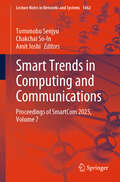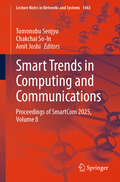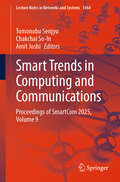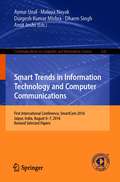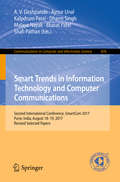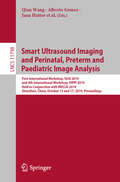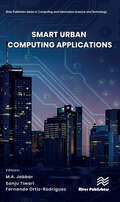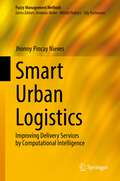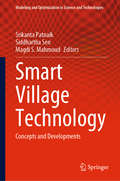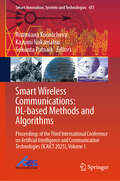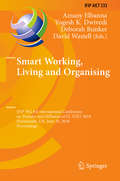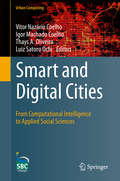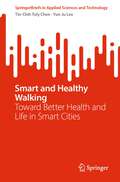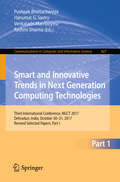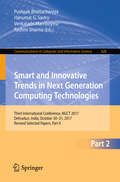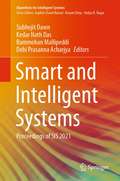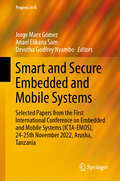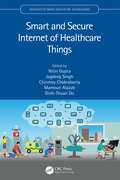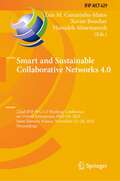- Table View
- List View
Smart Trends in Computing and Communications: Proceedings of SmartCom 2025, Volume 7 (Lecture Notes in Networks and Systems #1462)
by Amit Joshi Tomonobu Senjyu Chakchai So-InThis book gathers high-quality papers presented at the Ninth International Conference on Smart Trends in Computing and Communications (SmartCom 2025), organised by Global Knowledge Research Foundation (GR Foundation) from 29 to 31 January 2025 in Pune, India. It covers state-of-the-art and emerging topics in information, computer communications, and effective strategies for their use in engineering and managerial applications. It also explores and discusses the latest technological advances in, and future directions for, information and knowledge computing and its applications.
Smart Trends in Computing and Communications: Proceedings of SmartCom 2025, Volume 8 (Lecture Notes in Networks and Systems #1463)
by Amit Joshi Tomonobu Senjyu Chakchai So-InThis book gathers high-quality papers presented at the Ninth International Conference on Smart Trends in Computing and Communications (SmartCom 2025), organised by Global Knowledge Research Foundation (GR Foundation) from 29 to 31 January 2025 in Pune, India. It covers state-of-the-art and emerging topics in information, computer communications, and effective strategies for their use in engineering and managerial applications. It also explores and discusses the latest technological advances in, and future directions for, information and knowledge computing and its applications.
Smart Trends in Computing and Communications: Proceedings of SmartCom 2025, Volume 9 (Lecture Notes in Networks and Systems #1464)
by Amit Joshi Tomonobu Senjyu Chakchai So-InThis book gathers high-quality papers presented at the Ninth International Conference on Smart Trends in Computing and Communications (SmartCom 2025), organised by Global Knowledge Research Foundation (GR Foundation) from 29 to 31 January 2025 in Pune, India. It covers state-of-the-art and emerging topics in information, computer communications, and effective strategies for their use in engineering and managerial applications. It also explores and discusses the latest technological advances in, and future directions for, information and knowledge computing and its applications.
Smart Trends in Information Technology and Computer Communications
by Amit Joshi Durgesh Kumar Mishra Aynur Unal Malaya Nayak Dharm SinghThis book constitutes the refereed proceedings of the First International Conference on Smart Trends in Information Technology and Computer Communications, SmartCom 2016, held in Jaipur, India, in August 2016. The 106 revised papers presented were carefully reviewed and selected from 469 submissions. The papers address issues on smart and secure systems; technologies for digital world; data centric approaches; applications for e-agriculture and e-health; products and IT innovations; research for knowledge computing.
Smart Trends in Information Technology and Computer Communications: First International Conference, SmartCom 2016, Jaipur, India, August 6–7, 2016, Revised Selected Papers (Communications in Computer and Information Science #628)
by Amit Joshi Durgesh Kumar Mishra Aynur Unal Malaya Nayak Dharm SinghThis book constitutes the refereed proceedings of the First International Conference on Smart Trends in Information Technology and Computer Communications, SmartCom 2016, held in Jaipur, India, in August 2016.The 106 revised papers presented were carefully reviewed and selected from 469 submissions. The papers address issues on smart and secure systems; technologies for digital world; data centric approaches; applications for e-agriculture and e-health; products and IT innovations; research for knowledge computing.
Smart Trends in Information Technology and Computer Communications: First International Conference, Smartcom 2016, Jaipur, India, August 6-7, 2016, Revised Selected Papers (Communications In Computer And Information Science #628)
by Aynur Unal Malaya Nayak Dharm Singh A. V. Deshpande Kalpdrum Passi Bharat Patel Shafi PathanThis book constitutes the refereed proceedings of the Second International Conference on Smart Trends in Information Technology and Computer Communications, SmartCom 2017, held in Pune, India, in August 2017.The 38 revised papers presented were carefully reviewed and selected from 310 submissions. The papers address issues on smart and secure systems; smart and service computing; smart data and IT innovations.
Smart Ultrasound Imaging and Perinatal, Preterm and Paediatric Image Analysis: First International Workshop, SUSI 2019, and 4th International Workshop, PIPPI 2019, Held in Conjunction with MICCAI 2019, Shenzhen, China, October 13 and 17, 2019, Proceedings (Lecture Notes in Computer Science #11798)
by Qian Wang Andrew Melbourne Emma Robinson Roxane Licandro Kristin McLeod Alberto Gomez Jana Hutter Veronika Zimmer Oliver Zettinig Daan Christiaens Esra Abaci TurkThis book constitutes the refereed joint proceedings of the First International Workshop on Smart Ultrasound Imaging, SUSI 2019, and the 4th International Workshop on Preterm, Perinatal and Paediatric Image Analysis, PIPPI 2019, held in conjunction with the 22nd International Conference on Medical Imaging and Computer-Assisted Intervention, MICCAI 2019, in Shenzhen, China, in October 2019.The 10 full papers presented at SUSI 2019 and the 10 full papers presented at PIPPI 2019 were carefully reviewed and selected.The SUSI papers cover a wide range of medical applications of B-Mode ultrasound, including cardiac (echocardiography), abdominal (liver), fetal, musculoskeletal, and lung. The PIPPI papers cover the detailed scientific study of volumetric growth, myelination and cortical microstructure, placental structure and function.
Smart Urban Computing Applications
by M. A. Jabbar Sanju Tiwari Fernando Ortiz-RodriguezThis edited book is a collection of quality research articles reporting research advances in the area of deep learning, IoT and urban computing. It describes new insights based on deep learning and IoT for urban computing and is useful for architects, engineers, policymakers, facility managers, academicians, and researchers who are interested in expanding their knowledge of the applications of deep learning trends involving urban computing.
Smart Urban Logistics: Improving Delivery Services by Computational Intelligence (Fuzzy Management Methods)
by Jhonny Pincay NievesLast-mile delivery in cities, where the main problems are the traffic situation and ensuring access to customers’ homes while maintaining their privacy, poses a substantial logistical challenge. This book explores how the service area of mobility, especially last-mile delivery, can be improved and smartified. It demonstrates how a design science method and a transdisciplinary approach have been used to create a traffic area analysis tool that can accommodate the uncertainty and incompleteness of geospatial data; a linguistic traffic merging tool; and a customer classifier. In terms of developing the optimization artifacts, the socio-economic and logistical aspects of cities were considered and fuzzy logic and nature-inspired swarm intelligence (fuzzy ant colony optimization) were applied as basic principles. Pursuing a transdisciplinary approach, the book offers both practical know-how from the industry and theoretical findings, making it a valuable asset for researchers and practitioners in the fields of mobility and logistics.
Smart VR/AR/MR Systems for Professionals
by Gerrit Meixner Sunpreet Singh Karupppasamy Subburaj Kamalpreet Sandhu Saša Ćuković Radu Emanuil PetruseSmart VR/AR/MR Systems for Professionals is a comprehensive guide that explores the ground-breaking applications of virtual reality (VR), augmented reality (AR), and mixed reality (MR) in various industries. This book aims to equip practicing professionals with the knowledge and insights they need to harness the full potential of these immersive technologies in their respective fields. Through this book, the authors aim to explore the experimental breakthroughs and cutting-edge methodologies that have emerged in the realm of VR/AR/MR. The book delves deeper into the profound impact these technologies have had on the design process, computer-aided design, healthcare product development, manufacturing, human-robot collaboration, medical imaging, rehabilitation, and even phobia therapy. In each chapter of this book, we delve into specific topics, uncovering the principles, methodologies, and best practices that professionals can adopt. Examples of these topics range from empowering design processes with virtual reality to revolutionizing computer-aided design, and from exploring AR/VR/MR technologies in healthcare to transforming manufacturing with digital twins and metrology in VR. The book aims to provide practitioners with valuable insights, real-world examples, and practical guidance to navigate the ever-evolving landscape of VR/AR/MR systems.
Smart Village Technology: Concepts and Developments (Modeling and Optimization in Science and Technologies #17)
by Magdi S. Mahmoud Siddhartha Sen Srikanta PatnaikThis book offers a transdisciplinary perspective on the concept of "smart villages" Written by an authoritative group of scholars, it discusses various aspects that are essential to fostering the development of successful smart villages. Presenting cutting-edge technologies, such as big data and the Internet-of-Things, and showing how they have been successfully applied to promote rural development, it also addresses important policy and sustainability issues. As such, this book offers a timely snapshot of the state-of-the-art in smart village research and practice.
Smart Villages: Bridging the Global Urban-Rural Divide
by V. Kumar Murty Arun Chockalingam V. I. Lakshmanan S. KalyanasundaramThis book brings together technical expertise, best practices, case studies and ground-level application of the ideas for empowering the rural population of the world to live economically prosperous, environmentally sustainable, and socially progressive lives, on par or comparable with the quality of life enjoyed by the global urban population. The idea of Smart Villages takes on greater urgency in light of the investments made in this millennium on “Smart Cities”, taking advantage of the technological advances, particularly in digital connectivity. These investments have and will continue to expand the urban-rural divide, unless similar investments are made in the villages as well. The book provides a much-needed guide for a holistic development of a Smart Village, by defining the need, developing the framework, and describing the delivery, complete with successful case studies. Contributors to the book, from Canada, USA, Africa and India bring years of academic, industry and governmental experience, including organization of several Smart Village conferences. The knowledge base in the book will be of great value to anyone interested in or active in rural planning, including governmental and non-governmental organizations, industrial solution providers, public healthcare professionals, public policy professionals and students, as well as rural communities around the world. Consolidates all the aspects of creating/developing a Smart Village;Delivers an effective tool-kit for practitioners in the area of Smart Villages;Provides a policy-based framework for the development of an ideal Smart Village;Illustrates, through case studies, the fulfillment of key requirements of a Smart Village;Brings together experts from around the world to share their vision of a Smart Village;Highlights the importance of balancing development with social/gender equity and cultural traditions.
Smart Wireless Communications: Proceedings of the Third International Conference on Artificial Intelligence and Communication Technologies (ICAICT 2025), Volume 1 (Smart Innovation, Systems and Technologies #451)
by Srikanta Patnaik Kazumi Nakamatsu Roumiana KountchevaThis book gathers selected papers presented at the International Conference on Artificial Intelligence and Communication Technologies (ICAICT 2025), held at Jiangmen, China during June 2025. The proceedings is focused on the newest methods and algorithms in smart wireless communications in the areas of remote sensing and machine learning, intelligent image and data processing, health systems and security, intelligent teaching applications, and many others.
Smart Wireless Sensing: From IoT to AIoT
by Zheng Yang Yi Zhang Chenshu Wu Kun QianPerception of human beings has evolved from natural biosensor to powerful sensors and sensor networks. In sensor networks, trillions of devices are interconnected and sense a broad spectrum of contexts for human beings, laying the foundation of Internet of Things (IoT). However, sensor technologies have several limitations relating to deployment cost and usability, which render them unacceptable for practical use. Consequently, the pursuit of convenience in human perception necessitates a wireless, sensorless and contactless sensing paradigm.Recent decades have witnessed rapid developments in wireless sensing technologies, in which sensors detect wireless signals (such as acoustic, light, and radio frequency) originally designed for data transmission or lighting. By analyzing the signal measurements on the receiver end, channel characteristics can be obtained to convey the sensing results. Currently, significant effort is being devoted to employing the ambient Wi-Fi, RFID, Bluetooth, ZigBee, and television signals for smart wireless sensing, eliminating the need for dedicated sensors and promoting the prospect of the Artificial Intelligence of Things (AIoT). This book provides a comprehensive and in-depth discussion of wireless sensing technologies. Specifically, with a particular focus on Wi-Fi-based sensing for understanding human behavior, it adopts a top-down approach to introduce three key topics: human detection, localization, and activity recognition. Presenting the latest advances in smart wireless sensing based on an extensive review of state-of-the-art research, it promotes the further development of this area and also contributes to interdisciplinary research.
Smart Working, Living and Organising: IFIP WG 8.6 International Conference on Transfer and Diffusion of IT, TDIT 2018, Portsmouth, UK, June 25, 2018, Proceedings (IFIP Advances in Information and Communication Technology #533)
by Yogesh K. Dwivedi David Wastell Amany Elbanna Deborah BunkerThis book constitutes the refereed proceedings of the IFIP WG 8.6 International Working Conference "Smart Working, Living and Organising" on Transfer and Diffusion of IT, TDIT 2018, held in Portsmouth, UK, in June 2018. The 17 revised full papers and 2 short papers presented were carefully reviewed and selected from 34 submissions. They deal with the adoption of new classes of technology used by individuals, organisations, sectors and society with a particular focus on how emerging technologies are adopted and appropriated in organisations and everday life and their impact. The papers are organized in the following topical sections: being smart: adoption challenges; sharing economy and social media; government and infrastructure; IT project management; and revisiting concepts and theories.
Smart and Digital Cities: From Computational Intelligence to Applied Social Sciences (Urban Computing)
by Vitor Nazário Coelho Igor Machado Coelho Thays A. Oliveira Luiz Satoru OchiThis book presents up-to-date information on the future digital and smart cities. In particular, it describes novel insights about the use of computational intelligence techniques and decentralized technologies, covering urban aspects and services, cities governance and social sciences. The topics covered here range from state-of-the-art computational techniques to current discussions regarding drones, blockchain, smart contracts and cryptocurrencies.The idealization of this material emerged with a journey of free knowledge exchange from a diverse group of authors, who met each other through four different events (workshops and special sessions) organized with the purpose of boosting the concepts surrounding smart cities.We believe that this book comprises innovative and precise information regarding state-of-the-art applications and ideas for the future of cities and society. It will surely be useful not only for the academic community but also to the industry professionals and city managers.
Smart and Healthy Walking: Toward Better Health and Life in Smart Cities (SpringerBriefs in Applied Sciences and Technology)
by Tin-Chih Toly Chen Yun-Ju LeeThis book examines smart technologies and their invaluable role in augmenting the walking experience of mobile users. From meticulously planned walking routes to precise footprint detection and analysis, as well as cutting-edge fall detection and prevention mechanisms, these intelligent technologies have the potential to revolutionize healthy and smart walking. Against the backdrop of the post-COVID-19 era, where unrestricted mobility has become pivotal for restoring normalcy, the demand for smart healthcare solutions has soared. The book explores latest advances in sensor technology, cloud computing, deep learning, and networking and related innovative applications that can leverage smart technologies to enhance healthy walking.
Smart and Innovative Trends in Next Generation Computing Technologies: Third International Conference, NGCT 2017, Dehradun, India, October 30-31, 2017, Revised Selected Papers, Part I (Communications in Computer and Information Science #827)
by Pushpak Bhattacharyya Hanumat G. Sastry Venkatadri Marriboyina Rashmi SharmaThe two-volume set CCIS 827 and 828 constitutes the thoroughly refereed proceedings of the Third International Conference on Next Generation Computing Technologies, NGCT 2017, held in Dehradun, India, in October 2017. The 135 full papers presented were carefully reviewed and selected from 948 submissions. There were organized in topical sections named: Smart and Innovative Trends in Communication Protocols and Standards; Smart and Innovative Trends in Computational Intelligence and Data Science; Smart and Innovative Trends in Image Processing and Machine Vision; Smart Innovative Trends in Natural Language Processing for Indian Languages; Smart Innovative Trends in Security and Privacy.
Smart and Innovative Trends in Next Generation Computing Technologies: Third International Conference, NGCT 2017, Dehradun, India, October 30-31, 2017, Revised Selected Papers, Part II (Communications in Computer and Information Science #828)
by Pushpak Bhattacharyya Hanumat G. Sastry Venkatadri Marriboyina Rashmi SharmaThe two-volume set CCIS 827 and 828 constitutes the thoroughly refereed proceedings of the Third International Conference on Next Generation Computing Technologies, NGCT 2017, held in Dehradun, India, in October 2017. The 135 full papers presented were carefully reviewed and selected from 948 submissions. There were organized in topical sections named: Smart and Innovative Trends in Communication Protocols and Standards; Smart and Innovative Trends in Computational Intelligence and Data Science; Smart and Innovative Trends in Image Processing and Machine Vision; Smart Innovative Trends in Natural Language Processing for Indian Languages; Smart Innovative Trends in Security and Privacy.
Smart and Intelligent Systems: Proceedings of SIS 2021 (Algorithms for Intelligent Systems)
by Kedar Nath Das Subhojit Dawn Debi Prasanna Acharjya Rammohan MallipeddiThis book is a collection of high-quality research papers presented at the International Conference on Smart and Intelligent Systems (SIS 2021), which will be held in Velagapudi Ramakrishna Siddhartha Engineering College (VRSEC), Andhra Pradesh, India, during February 25–26, 2021, in virtual mode. It highlights how recent informatics intelligent systems have successfully been used to develop innovative smart techniques and infrastructure in the field of modern engineering and technology. The book will also be of interest to those working in the field of computational intelligence, smart computer network and security analysis, control and automation system, cloud computing, fog computing and IoT, smart grid communication, smart cities, solar cell synthesis and their performance, green technology, and many more. The contents of this book prove useful to researchers and professionals.
Smart and Intelligent Systems: The Human Elements in Artificial Intelligence, Robotics, and Cybersecurity (The Human Element in Smart and Intelligent Systems)
by Abbas Moallem"The more we know about smart and intelligent systems and their use, the more productive organizations can become, and the more quality of life will improve."—Gavriel Salvendy, President Academy of Science, Engineering and Medicine of Florida, University Distinguished Professor University of Central Florida" "Robots, drones, self-driving cars, and personal assistants are only some of the ‘intelligent’ and ‘smart’ systems which are populating our world and changing the way we use technology to carry out our everyday activities, bringing about both exciting opportunities for human-technology symbiosis, as well as compelling design and development challenges. Through a carefully selected choice of chapters, authored by top scientists in the field, this book, edited by Abbas Moallem, sheds light on fundamental aspects of intelligent and smart systems, investigating the role and impact of affective and psychophysiological computing, machine learning, cybersecurity, agent transparency, and human-agent teaming in the shaping of this new interaction paradigm, as well as the human factors involved in their application in critical domains such as health, education, and manufacturing in the emerging technological landscape."—Constantine Stephanidis, Professor of Computer Science, University of Crete, Distinguished member of Foundation for Research and Technology - Hellas (FORTH) In today’s digital world, the words "smart" and intelligent" are now used to label devices, machinery, systems, and even environments. What is a "smart" system? Is "smart" synonymous with "intelligent"? If not, what does an "intelligent system" mean? Are all smart systems intelligent? This book tries to answer these questions by summarizing the existing research in various areas and providing new research findings. Smart and Intelligent Systems: The Human Elements in Artificial Intelligence, Robotics, and Cybersecurity presents new areas of smart and intelligent system design. It defines smart and intelligent systems, offers a human factors approach, discusses networking applications, and combines the human element with smart and intelligent systems. This book is perfect for engineering students in data sciences and artificial intelligence and practitioners at all levels in the fields of human factors and ergonomics, systems engineering, computer science, software engineering, and robotics.
Smart and Secure Embedded and Mobile Systems: Selected Papers from the First International Conference on Embedded and Mobile Systems (ICTA-EMOS), 24-25th November 2022, Arusha, Tanzania (Progress in IS)
by Jorge Marx Gómez Anael Elikana Sam Devotha Godfrey NyamboThis book gathers a selection of research papers that delve into the field of smart systems, covering a wide range of applications in transportation, agriculture, healthcare, energy management, and more. Emphasizing the fusion of intelligence and security, they reveal how advanced embedded and mobile systems are paving the way for a smarter and safer future. The book presents peer-reviewed research articles from the First International Conference on Embedded and Mobile Systems (ICTA-EMOS), which was held on November 24th – 25th, 2022, in Arusha, Tanzania. The book showcases the remarkable potential of advanced technologies in shaping a smarter and more secure world, addressing topics such as transportation and mobility solutions, smart manufacturing and agriculture, ICT infrastructure and resource management, healthcare and energy management, system integration and control, and solutions for innovation and monitoring.
Smart and Secure Internet of Healthcare Things (Advances in Smart Healthcare Technologies)
by Nitin Gupta Jagdeep Singh Mamoun Alazab Chinmay Chakraborty Dinh-Thuan DoInternet of Healthcare Things (IoHT) is an Internet of Things (IoT)-based solution that includes a network architecture which allows the connection between a patient and healthcare facilities. This book covers various research issues of smart and secure IoHT, aimed at providing solutions for remote healthcare monitoring using pertinent techniques. Applications of machine learning techniques and data analytics in IoHT, along with the latest communication and networking technologies and cloud computing, are also discussed. Features: Provides a detailed introduction to IoHT and its applications Reviews underlying sensor and hardware technologies Includes recent advances in the IoHT, such as remote healthcare monitoring and wearable devices Explores applications of data analytics/data mining in IoHT, including data management and data governance Focuses on regulatory and compliance issues in IoHT This book is intended for graduate students and researchers in Bioinformatics, Biomedical Engineering, Big Data and Analytics, Data Mining, and Information Management, IoT and Computer and Electrical Engineering.
Smart and Sustainable Agriculture: First International Conference, SSA 2021, Virtual Event, June 21-22, 2021, Proceedings (Communications in Computer and Information Science #1470)
by Selma Boumerdassi Éric Renault Mounir GhoghoThis book constitutes the refereed proceedings of the First International Conference on Smart and Sustainable Agriculture, SSA 2021, held as a virtual event in June 2021. The 12 papers presented were thoroughly reviewed and selected from the 25 qualified submissions. The papers provide discussion on new trends in communication and networking, Internet of Things, data processing for smart agriculture, renewable-energy based devices, low-cost solutions for wide-area exploitations and developing countries, smart agriculture and urban farming, smart irrigation, application to small-size andlarge-size exploitations, application of ancestral farming to smart agriculture, waste management for agriculture 2.0, and census of regional ancestral farming.
Smart and Sustainable Collaborative Networks 4.0: 22nd IFIP WG 5.5 Working Conference on Virtual Enterprises, PRO-VE 2021, Saint-Étienne, France, November 22–24, 2021, Proceedings (IFIP Advances in Information and Communication Technology #629)
by Luis M. Camarinha-Matos Hamideh Afsarmanesh Xavier BoucherThis book constitutes the refereed proceedings of the 22nd IFIP WG 5.5 Working Conference on Virtual Enterprises, PRO-VE 2021, held in Saint-Étienne, and virtually in November 2021.The 70 papers (15 full and 55 short) presented with 5 industrial workshop papers were carefully reviewed and selected from 189 submissions. They provide a comprehensive overview of major challenges and recent advances in various domains related to the digital transformation and collaborative networks and their applications with a strong focus on the following areas related to the main theme of the conference: sustainable collaborative networks; sustainability via digitalization; analysis and assessment of business ecosystems; human factors in collaboration 4.0; maintenance and life-cycle management; policies and new digital services; safety and collaboration management; simulation and optimization; complex collaborative systems and ontologies; value co-creation in digitally enabled ecosystems; digitalization strategy in collaborative enterprises’ networks; pathways and tools for DIHs; socio-technical perspectives on smart product-service systems; knowledge transfer and accelerated innovation in FoF; interoperability of IoT and CPS for industrial CNs; sentient immersive response network; digital tools and applications for collaborative healthcare; collaborative networks and open innovation in education 4.0; collaborative learning networks with industry and academia; and industrial workshop.
